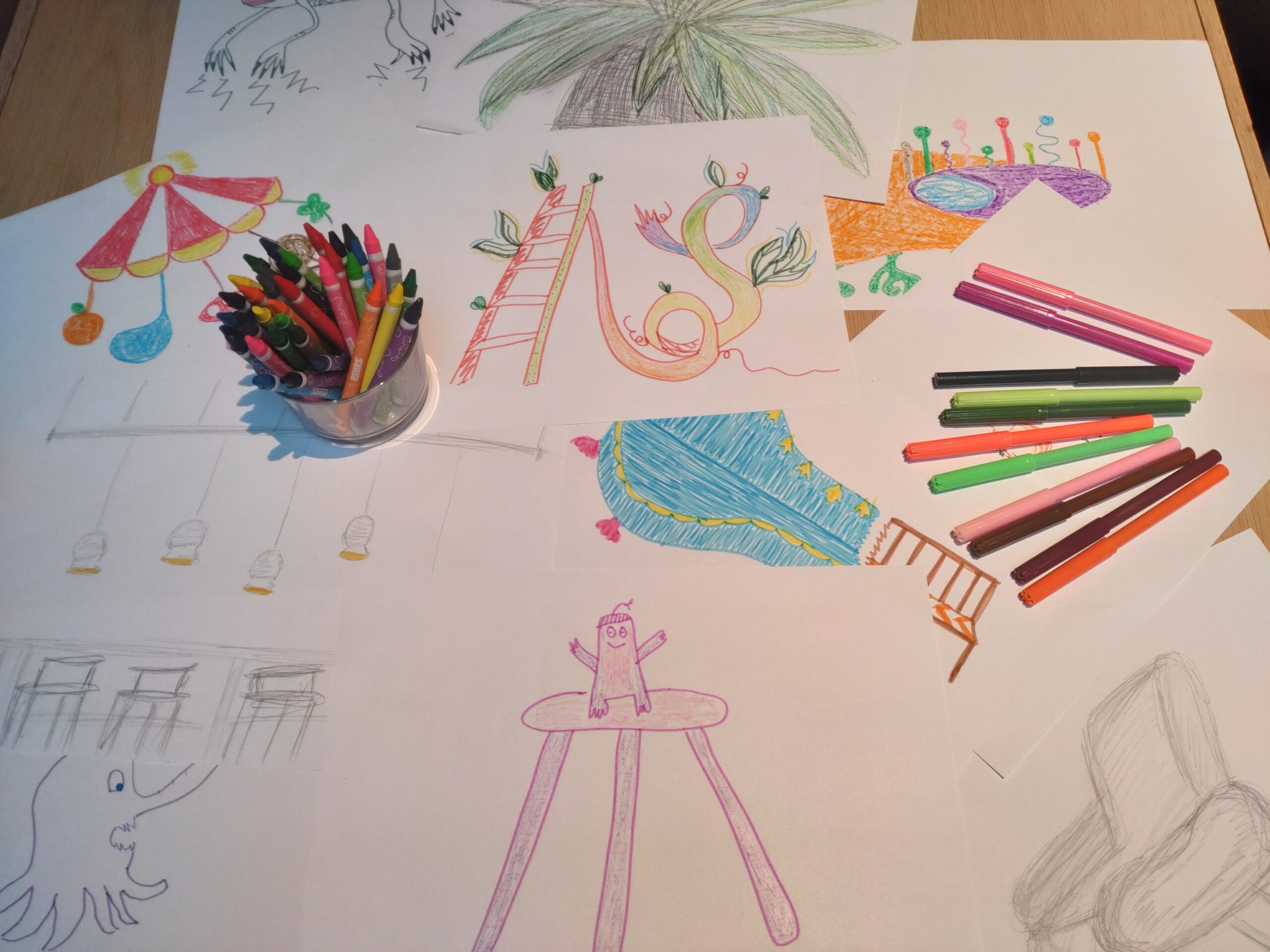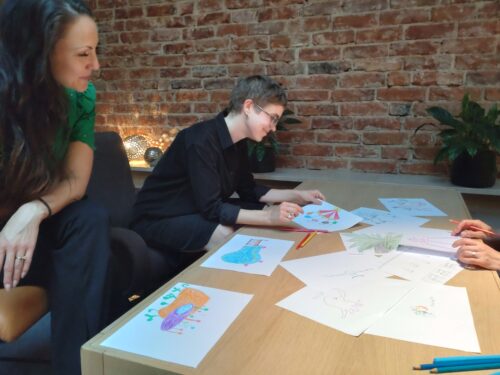Exploring with Metaphors
It is said that life is different for people who think in metaphors, but can we think differently about life with metaphorical thinking? Metaphors have become part of the speculative toolbox used to challenge habitual thinking and illuminate assumptions we might not be aware of (Ivie, 1996). In the hub, we developed a workshop method for applying metaphorical thinking about education. Below, we share our notes and insights about how it went. We recommend this method for exploratory conversations about bigger topics but identify that some people might feel uncomfortable with the drawing activity (in which case digital images might be a better option). In addition, we note that metaphors may open up for deeper or more personal reflections about topics, which should be considered by facilitators from an ethical standpoint.

Trying it out
In the stage of planning this workshop, we aimed to create an explorative space for considering the topic of education through two frames (i.e. ways of imagining the futures), which were introduced step-wise. Five people participated, including the facilitator, and brought perspectives from law, design, childhood, parenting, ethics, and environmental work.
Step 1 – Consider the future of education
“How do you imagine education in the year 2035? Illustrate your visions in the form of a piece of furniture or an animal.”
Drawing on classifications of the future in futures studies, we asked participants to imagine a possible future of education, represented in the form of furniture or animals. These metaphors were chosen as they may be depicted in a wide range of ways, and convey emotions (or even spark them!). To convey their visions, participants drew pictures and after that presented their drawings to each other and explained their meaning.
Step 2 – Consider the future of education
“Imagine a desirable future of education. In this future, the aim of education is to contribute to the wellbeing in society. Illustrate your visions in the form of a piece of furniture or an animal.”
To explore alternative futures we, inspired from speculative methods and futures literacy labs, introduced the participants to a new interpretive frame for considering the future of education. In this alternative future, the core of education and its fundamental aim was to contribute to the wellbeing in society. While The Education Act in Sweden stipulates that the purpose of education is gaining and developing knowledge and values (Skollag 2010:800, our translation), such purposes may draw on different underlying discursive ideas and opinions of, for instance, the worth of various values centralized in education, and the reasons for why children should develop specific knowledge.
By choosing an interpretive frame that centered wellbeing as the underlying logic, we wanted to illuminate contrasting underlying ideas that may be guiding educational practices, and problematize eventual assumptions made in the first part of the workshop. As such, the participants were asked to consider the future of education by this new frame and draw new images by the same metaphorical objects, i.e. animals and furniture.
 Outcomes
Outcomes
The images produced by participants conveyed schools that were friendly and inviting to children, building on their curiosity and hunger for learning. Images depicted “smörgåsbords” of knowledge, platforms for meetings and learning, broad pots for large root systems and plants with a variety of foliages, animals that couldn’t be labeled by current taxonomies, and picture frames that were open to other formats than squared artwork.
To deepen our insights about our assumptions and critical reflections about education, we considered how we drew animals and furniture in the first step. Using the approach of exploring with metaphors, we identified that current schooling might build on the assumptions that learning has to be forced by law and strict routines found in schooling. We considered that such an assumption may reflect or reinforce ideas about children and their interest in learning. Additionally, we identified that current ways of “delivering knowledge” from teachers to students, assume that children are “rootless” (depicted by a plant with the same sorts of leaves, and entangled and complex root systems hidden by the plant’s pot). We reflected on what the cultivation of and learning from roots could mean in the school system. Furthermore, we shared images of fun, cozy, and whimsical environments and animals that reflected the wide range of needs and identities that can be found in classrooms, and better solutions for cultivating knowledge in a caring and sensitive way.
Methodological reflections
By exploring the future of education metaphorically, we allowed for participants’ reflections and visions to evolve by sensing and sense-making in color, texture, and a rich variety of features found in animals and furniture. We found this method to be most helpful for allowing for complexity in conveying thoughts and vision, often reduced in the process of wording and language. Additionally we found the activity fun and good as an icebreaker.
References:
Ivie, S. D. (1996). Metaphors: Tools for Critical Thinking. MCGILL JOURNAL OF EDUCATION, 31(1), 57–68.
Jarrett, C. (2015) Life is different for people who think in metaphors. British Psychological Society.
Gall,T., Vallet F., Yannou, B. (2022) How to visualise futures studies concepts: Revision of the futures cone, Futures, Volume 143.
SpeculativeEdu, Approaches, methods and tools for Speculative Design, https://speculativeedu.eu/approaches-methods-and-tools-for-speculative-design/
UNESCO, Futures Literacy, https://www.unesco.org/en/futures-literacy
Different types of metaphors
Metaphor mapping
Explore a problem by mapping our potential dominant metaphors. For instance, you might view an organization as a ”family” or an ”ecosystem”. This approach can bring a common frame of reference for a group of problem solvers, make conflicting ideas visible, and can facilitate innovative idea generation.
Metaphor transfer
Explore metaphors from different domains and transfer them to your problem domain. Ask yourself ”What if we viewed this problem through a different metaphor?”. By borrowing metaphors from other areas, you can break out of traditional thinking patterns and open up new possibilities for exploring and solving a problem. For instance, if you’re stuck on a design problem, you might consider metaphors from nature, music, or sports to spark new perspectives.
Reverse metaphors
Challenge the conventional use of metaphors in a domain by intentionally reversing them. This can help break down assumptions and encourage unconventional thinking. For example, if a problem is commonly associated with a ”battle” metaphor, explore what it would mean to reverse it and use e.g. ”dance” as a metaphor instead.
Sensory metaphors
Engage your senses and explore metaphors that evoke sensory experiences related to the problem – for example, metaphors related to touch, taste, smell, or sound. These sensory metaphors can inspire innovative ideas and enhance the user experience.
Metaphor storming
Adapt the concept of brainstorming to metaphor generation. Gather a group of people and encourage them to generate as many metaphors as possible related to the problem at hand. Then group and discuss the different metaphors. This exercise can cultivate a creative environment and help inspire innovative solutions by exploring various metaphorical lenses.
Metaphor resources